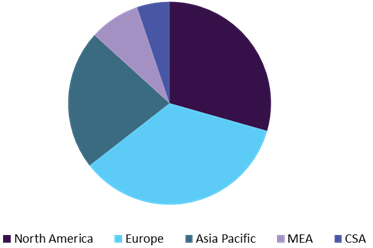Colorants Industry Outlook: Rapid commercialization of natural pigments
The colorants in the consumer products such as textiles, food & beverages, and plastic products are of high importance, as they reflect upon the freshness, attractiveness, and taste of finished products. Synthetic inorganic ingredients are observed to have toxic effect on consumer’s health, and to avoid this, natural colorants are more extensively utilized in various end-use industries. This has offered ample scope of growth to the natural colorants despite the fact that they are less stable in presence of heat and light, expensive to produce, and low consistency in color range.
Approach for fermentative production techniques has been adopted for few colorants. Extensive strain, metabolic control, and process development has been required for dyestuff biosynthesis in order to launch a cost-effective production process. Furthermore, color synthesis through biotransformation of adequate precursors can be used. In these types of processes, algae represent a potential set of microorganisms that participate in the production of various colorants, and downstream technologies and dedicated fermentation have been developed.
Major manufacturers of dyes & pigments for inks, paints, textiles, and plastics have adopted a standard called Colour Index International (CII) for pigment identification. The jointly published index in collaboration with the American Association of Textile Chemists and Colorists (U.S.). The Society of Dyers and Colourists (UK) is internationally recognized as the authoritative reference for various colors and dyes & pigments. It includes nearly 13,000 generic color index names and under which almost 27,000 products.
Dyes & pigments must have some attributes that determine their suitability for specific production processes and applications, which include sensitivity for damage from ultra violet light and lightfastness, heat stability, tinting strength, toxicity, dispersion, opacity or transparency, reactions & interactions, and resistance to alkalis and acids.
Various regulatory bodies have been established around the world for testing the product safety such as in the U.S., FD&C numbers (used for foods, drugs and cosmetics colorants) are allotted to synthetic food dyes as an approval, while in Europe, E numbers are assigned to all additives, both natural and synthetic, which is approved by European Food Safety Authority Directive 94/36/EC, enacted by the European Commission in 1994.
Global colorants market revenue by region, 2015 (USD Million)

Food colorants are most widely used additives with both beneficial and adverse effects. While the European Union has applied regulations on labeling of food products, to inform consumers about the health risks associated with toxic color additives. The most commonly used dyes in food and cosmetic products have bad effects such as Blue 1 or referred as Brilliant Blue can cause kidney tumors, which is used in desert powders, baked goods, beverages, drugs, cereal, and candies. Similarly, usage of Citrus Red 2 is noxious to rodents at moderate levels and caused tumors in the urinary system.
Colorant manufacturing companies have introduced advanced technologies in the fields of ink-jet printing and textile dyes, boosting cotton fiber fixing rates and sinking the chemicals consumption rate. Moreover, microorganisms break down the waste, thus improve treatment efficiency owing to the low proton acid and residual color in the waste water.
Commercial thermochromic and photochromic colorants that vary reversibly from colorless state to colored when triggered by pH, temperature and ultraviolet irradiation are class of colorants used for manufacturing of niche products such as food packaging, medical thermography, photochromic lenses, plastic strip thermometers and nondestructive testing of electronic circuitry and engineered articles. The research on application of thermochromic and photochromic on textiles has boosted significantly in the last few years, which has the capability to unlock nascent high-tech applications.
 In-depth report on global colorants market by Grand View Research:
In-depth report on global colorants market by Grand View Research:
http://www.grandviewresearch.com/industry-analysis/colorants-market
To schedule a free market intelligence database demo, please complete the form below:
Service Guarantee
-
Insured Buying
This report has a service guarantee. We stand by our report quality.
-
Confidentiality
Your transaction & personal information is safe and secure.
-
Custom research service
Design an exclusive study to serve your research needs.
-
24/5 Research support
Get your queries resolved from an industry expert.